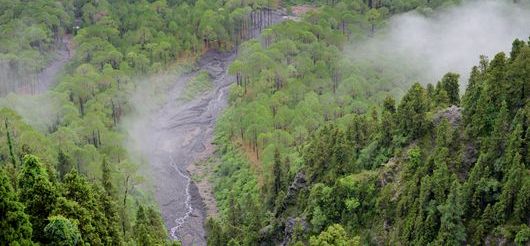Forest restoration has received a great deal of attention from scientists and policymakers for its potential contribution to climate change mitigation (Shukla et al., 2019). Natural climate solutions may be able to provide more than a third of the carbon capture from the atmosphere needed in order to limit the risks of climate change above 1.5 ºC (Griscom et al., 2017). Forests have the largest potential of these natural climate solutions. Forest restoration also has important links with biodiversity, as restoration of stable forests that provide multiple ecosystem services requires a functional understanding of the biodiversity that underpins ecosystem functioning (Aerts and Honnay, 2011). Forest restoration is thus included along with conservation in the decisions and targets of the Sustainable Development Goals, the Convention on Biological Diversity, the UN Decade on Ecosystem Restoration, and the Bonn Challenge. Forest restoration follows processes of forest degradation and deforestation, which are dealt with in separate modules in the Sustainable Forest Management Toolbox.
Recently the concept of Forest and Landscape Restoration has become prominent. This refers to the restoration not only of the forest cover at a particular site, but views the site in the context of the landscape as a whole; it includes all land uses and the people in it. Forest and Landscape Restoration is covered in a separate module: the Forest and Landscape Restoration Module deals with the restoration of many sites within the context of a multiple-use landscape.
This module therefore deals with forest and its restoration at the site level. However, it is very important that even when dealing with forest restoration at a single site that this site be considered in its environmental and social context. Guiding principles are presented in more depth, and the reader is directed to specific reference works in the tools section of this module. Cases are presented across ecological zones to illustrate concepts of site-based restoration.
Forest restoration encompasses a large variety of staring points and objectives. It is thought of as reversing forest degradation or loss of productivity of ecosystem goods and services such as food, wood, biodiversity, and water. As a consequence of human activity and other natural processes, these types of needs for restoration are found all over the world’s forests, from drylands to tropical rainforests, from high latitudes and altitudes, and from poor to rich regions. By some estimates, the annual economic losses due to deforestation and land degradation were EUR 1.5–3.4 trillion in 2008, equalling 3.3–7.5 per cent of the global GDP at that time (ELD Secretariat, 2015).
Forest restoration includes:
- rehabilitation, meaning the restoration of desired species, structures or processes to an existing ecosystem;
- reconstruction, meaning restoration of native plants on land which is in another use;
- reclamation, meaning restoration of severely degraded land devoid of vegetation;
- most radically replacement, in which species or provinces maladapted for a given location and unable to migrate are replaced with introduced species as climates change rapidly.
(Stanturf, Palik and Dumroese, 2014)
Forest restoration can be understood in relation to the forest transition curve shown in Figure 1. Rehabilitation would normally be carried out in order to restore the productivity of a forest in the degraded stage whilst reconstruction or reclamation would be carried out in forests that were so degraded as to have ceased functioning as effective forests. In many parts of the world, land abandoned from agricultural purposes will regenerate naturally to form secondary forests that are in their nature and composition different from the forests that preceded them. Active management can accelerate this process or change the trajectory of the succession so that the structure or composition better achieves certain management objectives. Disasters, including fires and high winds, may cause the loss of forest cover over large areas, and this may require restoration in order to accelerate natural regeneration processes and a return to a more productive condition.
Figure 1. Land that is ecologically suitable for forest often transitions from primary forest to an unproductive forest state or a non-forest state due to exploitative management. Once that occurs, forest restoration can accelerate a transition back to a productive forest state (source: https://www.forestryandclimate.com).
When thinking about forest restoration in terms of the forest transition curve, it is important to consider ecological differences between forest types. For example, forest successions proceed quite differently in tropical moist forests compared to dry forests; in moist forests early successional trees usually have timber of low density and strength while trees appearing later have denser, stronger timber. In dry forest the opposite is true, with early successional trees typically having very dense timber while later successional trees have lighter, weaker timber (Poorter et al., 2019). This is a result of the changes in the ambient moisture of the environment caused by the forest cover and by competition between the trees. Moreover, in dry forests establishment of trees from out planted seedlings is often less cost-effective than reliance on direct seeding and regeneration of rootstocks.
There are many ways forest owners and managers can restore forest, including planting of seedling regeneration, removal or control of less desired species, or weeding to reduce competition. Natural regeneration is promoted by protection from fire or from grazing animals. Forest restoration is not necessarily restricted to natural forest systems, since, in many cases, either as a result of neglect or due to the disruption of normal life due to civil unrest or war, planted forests have become degraded due to lack of management or lack of protection. Plantations may have trees that are overmature and incapable of meeting their original purpose, or may otherwise not have enough crop trees to make them financially viable. In some cases, plantations of exotic species may be used as nurse crops both to provide shelter for shade-tolerant species and to provide a source of income to finance the restoration process. The next section of this module will explain in greater depth how some of these options may be successfully implemented.




